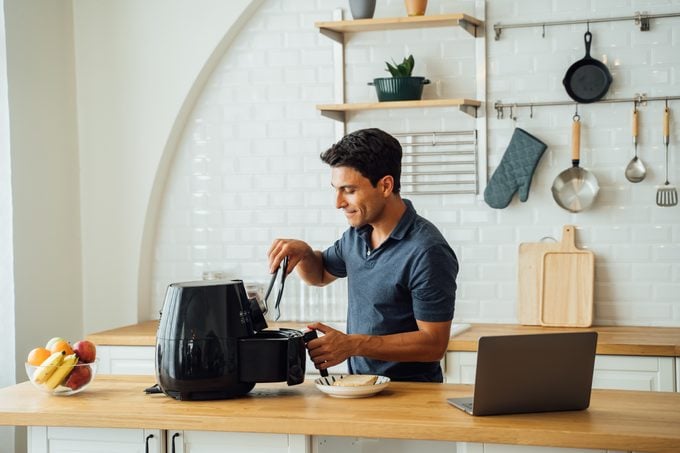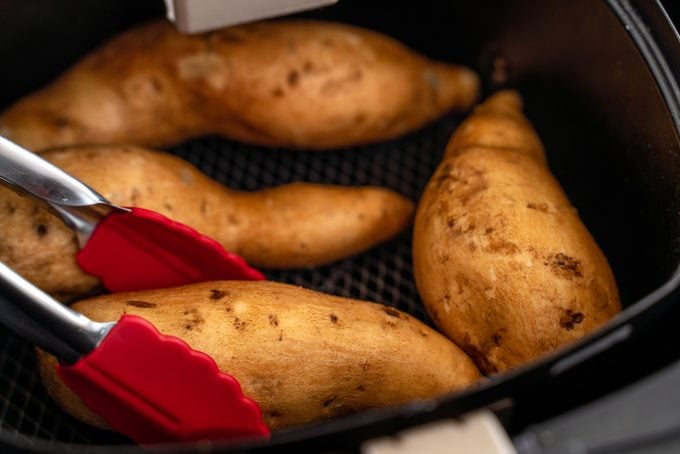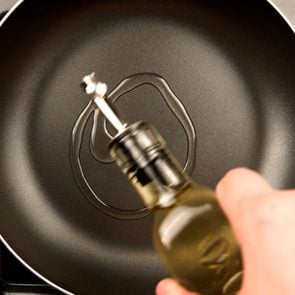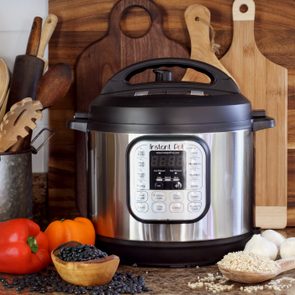Are Air Fryers Healthy? Here’s What Registered Dietitians Say
Updated: Jun. 10, 2021
Air fryers are considered to be a healthful way to cook. Find out how air fryers compare to pan frying, baking, and other cooking methods—and if the results are actually nutritious.
The rising popularity of the air fryer
There’s a lot of talk of air fryers these days. It seems like nearly everyone is hopping on the trend. But if you’re skeptical, you’re not alone.
Air frying seems too quirky for some. Others have no idea what it is.
“I didn’t understand the hype for a while, but now I’m obsessed with my air fryer,” says Sammi Haber Brondo, a registered dietitian and founder of Sammi Brondo Nutrition. “It’s a fast way to cook almost anything and always yields good results.”
(Avoid making these cooking mistakes that make your food more toxic.)
What does an air fryer do?
An air fryer is a small kitchen appliance. Cooking in it—air frying—can help you prepare foods with less oil than pan frying, significantly less oil than deep frying, or no cooking oil at all.
It’s “essentially a convection oven,” says Abbie Gellman, a New York City-based chef and registered dietitian. “However, the fan that circulates the air spins more quickly.”
A convection oven cooks food faster than a standard conventional oven, saving energy. While an air fryer may use the same principles of cooking, it comes with a big bonus: air circulation.
“Because the food is placed in a basket with holes, the air can circulate to all portions of the food and cook at roughly the same rate,” Gellman says.
That’s why air frying produces a crispy texture on par with deep frying.
“I’d say it’s similar to ‘oven frying,’ but because of the circulating air, you can achieve a similar crispy texture using less oil,” says Marisa Moore, a culinary and integrative dietitian.
The hot, dry, swirling air of an air fryer crisps and caramelizes (browns) the outside of foods while keeping them moist on the inside. The palates of fried food aficionados will be pleased.

The air frying trend
Air frying isn’t a fad. This countertop “convection oven” has been on the scene since 2010, when Philips, a health technology-focused company, launched the first air fryer.
And according to Data Bridge Market Research, the global air fryer market is expected to grow by 10.7 percent from 2021 to 2028.
Its rise in kitchen stardom is mostly thanks to health- and calorie-conscious consumers.
“Air frying has become trendy because it generally uses less oil than you would when pan frying, deep frying, or roasting but still have a caramelized, crunchy result,” says Gellman.
In short, it’s popular because it combines health-conscious cooking with America’s favorite thing: the taste of deep-fried food.
But not everyone is fully convinced of the air fryer’s staying power.
“I’m not sure if air fryers will be as popular a few years from now,” says Moore. “But air frying is fun and provides a less-messy way to cook some of my favorites.”
(Make sure you know the smoke point of oils before you start cooking.)
Best foods to air fry
“Vegetables are amazing in an air fryer,” says Brondo. “Just add a little bit of olive oil, salt, pepper, and any herbs or spices.”
Her favorites to “fry” up are carrots, sweet potatoes, and brussels sprouts.
Gellman loves air frying potatoes, sweet potatoes, broccoli, and cauliflower. She’s a big fan of air frying kale and potatoes into chips. (You can try her air-fried tofu and chicken wings.)
But don’t stop there. Consider air frying fish, green beans, Indian dishes like Tandoori Paneer Tikka, and other globally inspired foods.
You can try popular picks like personal-sized pizza, crispy chickpea snacks, apple “chips,” frozen veggie burger patties, and an occasional petite batch of cookies.
Are air fryers healthy?
An air fryer can provide several potential benefits, and not just for your health. Here are a few:
It’s calorie friendly
Air frying can offer similar crispiness as deep frying, with up to 90 percent less fat.
As Gellman explains, excess oil falls to the bottom of the air fryer. So you consume less oil in air-fried foods.
Less oil means fewer calories, all without negatively impacting the food’s taste or texture. When trying to lose weight, that’s helpful.
Increases veggie intake
Since it’s easy to cook vegetables in it, using an air fryer may help increase your intake of plant-based foods. If the tool is already sitting on the countertop, it becomes a no-brainer for small batch prep.
And because the vegetables can taste like fried foods, it may help punch up consumption for people who normally avoid veggies.
Not only that, but you might get more nutrients from them, provided you use just a touch of oil.
A study published in the journal Antioxidants found that people with a high produce intake had higher levels of carotenoids (the beneficial yellow, orange, and red pigments naturally found in food) when their fat intake was low to moderate, but not when it was very high.
In other words, the body may hang onto these helpful antioxidants when we eat a little fat, but not too much—like with deep frying.
Promotes heart health
The heart health benefits of air frying have to do with the ingredients you use as well as the method of cooking.
Since air frying makes it easy to cook super-tasty veggies, you can cook up non-starchy vegetables that offer heart-protective benefits. You can choose to use a heart-healthful oil, like extra-virgin olive oil, in an air fryer. In fact, entire air fried meals can be heart friendly.
Not only that, but you’re doing your heart a favor by choosing this cooking method instead of deep frying.
A 2019 randomized crossover trial published in Current Developments in Nutrition found that air frying a typical meal led to lower post-meal levels of triglyceride—a type of fat found in the blood—than deep frying.
(Follow these heart doctors’ heart health tips.)
Saves energy
“I love air frying because of how quick it is,” says Brondo.
Since an air fryer is a small appliance, uses convection, and doesn’t need preheating, it’s generally considered an energy saver.
“In my view, air frying is also popular because it does not heat up the entire kitchen when cooking something,” says Gellman. “For some, it’s a simpler appliance to use and takes less time and energy compared to cooking in an oven or even the stove.”
It’s kid friendly
Frying can mean hot oil splatters that can cause burns. Ouch! That’s not kid (or adult or pet) friendly. Luckily, an air fryer helps you achieve results similar to frying without potentially hazardous splatter.
With guidance, an air fryer can even be used by kids. Plus, air frying is ideal for heating popular kid picks, like frozen breaded fish sticks and chicken nuggets. (Of course, there are definitely healthier choices for kids.)
Offers cuisine versatility
Air frying allows the true food flavor to shine through. And though viewed as an alternative to frying, it can often be swapped in for baking, roasting, toasting, reheating, grilling, and dehydrating.
“From the culinary side, I’ve found that some foods may crisp up more easily and more quickly in the air fryer versus the oven,” says Gellman.
What are the downsides of air frying?
Unfortunately, the benefits of air frying also come with caveats.
Now that you’re clear on the potential benefits of air frying, familiarize yourself with some ways the cooking method can be less than healthy.
You might lose good fats
Dropping oil from your diet isn’t necessarily healthy. Healthful oils, like extra-virgin olive oil and avocado oil, can be good for the heart.
Fat also boosts flavor while helping you absorb more health-protective plant nutrients. So, ideally, you’ll still use some oil when air frying. (Although too much oil can have the opposite effect.)
It may boost formation of a carcinogen
But there’s another concern. The Center for Food Safety warns that air frying may lead to the formation of a carcinogen (cancer-causing chemical) called acrylamide.
Fortunately, research suggests that acrylamide formation is about 90 percent lower in air fried potatoes versus deep fried potatoes, per a 2015 study in the Journal of Food Science.
Adding fresh herbs, like parsley and chives, when air frying may help curb the creation of the harmful chemical, according to a 2017 study in the Journal of Food Science. Herbs reduce lipid oxidation, which refers to the loss of nutrients in foods with fat and the resulting diminished food quality.
Eating plenty of fresh produce, in general, can be protective. And since acrylamide is linked to cancer in very high amounts, consider eating air fried (herbed) French fries once a week, not daily, for instance.
You might assume everything is healthy
While an air fryer can prompt you to eat more veggies, it can also lead you to eat less-than-healthy foods.
Just because those breaded mozzarella sticks are air fried doesn’t mean you want to chow down like they’re celery sticks.
If you have an air fryer, you need to be mindful of what you’re eating and make sure you get a balanced diet.
Its shape may not be ideal
“The type of air fryer and shape of the basket may affect some of the cooking and resulting dishes,” says Gellman, who prefers a shallow, rectangular basket to lay out food in a single layer, allowing it to cook undisturbed.
“Many air fryers have a deep basket which means you’ll more likely have to stop cooking, shake the food and move it around, then continue cooking,” she says.
It can be too big
Simply put, an air fryer takes up valuable kitchen space. The family-sized model can weigh nearly 18 pounds with an approximate height of 17 inches and width and depth of 12.5 inches.
“I generally go through phases where I’ll have the air fryer out and use it frequently for a month, then will put it away because of kitchen space and not use it for months,” admits Gellman.
Despite taking up space, popular air fryer models can offer a relatively small cooking capacity—enough for just two to six servings. And overfilling the cooking basket can lead to a steamed texture, taste, and appearance.
It may not save you much time
“I don’t find [air frying] results to be very different from oven frying, especially if you have a convection option,” says Moore. “So when asked, I usually tell people that they don’t necessarily need an air fryer and can use the oven they already have to produce the same results.”
Gellman agrees. “Some people have told me that an air fryer cooks in much less time compared to an oven,” she says. “However, I haven’t found that to be true and often cook food for a similar amount of time.”
Moore also points to the added clean-up time required for an air fryer. Plus, you may need to cook in multiple batches since the cooking space is small. Unfortunately, that’s not energy saving.
Watch out for unrealistic expectations
An air fryer can yield good results, but that doesn’t mean food will automatically taste like a Michelin-starred chef did the cooking. Flavors are only as good as the ingredients you start with.
(These are the worst foods for your brain.)

Air frying vs. other cooking methods
In culinary terms, air frying stacks up well when compared with other cooking methods.
Air frying results can be tastier than microwaving because air frying allows for caramelization. It’s less temperamental than broiling because there’s no fear of scorching food in seconds.
And though not nearly as speedy as microwaving and broiling, it can be a tad faster than traditional baking or roasting.
“Unlike an oven, you don’t have to wait for anything to preheat, and you get a super crispy texture, similar to the one you’d get from broiling, in just a few minutes,” says Brondo.
The air fryer’s ability to caramelize foods is a big draw.
“Cooking methods such as steaming and boiling don’t provide that caramelized outside, so the results are different,” Gellman says.
Compared with traditional frying, air frying can give you fried-tasting results without an oily finish.
“An air fryer definitely helps to get that crunchy, crispy texture for many foods, if that’s what you’re after. Other cooking methods, including pan-frying (and roasting), can also get you those results, but the final product may vary depending on how much oil is used and the food itself,” says Gellman.
An air fryer may be a good fit after all
Ultimately, if you’re open to nontraditional culinary techniques, air frying can be a tasty, nutritious, and easy way to prepare food, especially veggies.
There are potential concerns. But you can get around the downsides.
The benefits seem to outweigh its negatives, especially if air frying helps you eat more veggies.
So if you’ve got the counter space and aren’t cooking for a large crew, an air fryer may be a good fit for your healthy lifestyle.
Healthy air fryer recipes to try
Don’t know where to start? Make these simple, healthy air fryer recipes from our experts.
- Air fryer fish: Moore created it to savor the flavors of her childhood favorite, fried fish, but with less effort.
- “Cheesy” Air Fryer Kale Chips: Brondo says they “taste just like the store-bought version.”
- Air Fryer Pickles: “This is probably my favorite air fryer recipe,” Gellman says.
Ready for more? See these 75 air fryer recipes you need to try.
And read this air fryer cooking guide to help you get started.




















